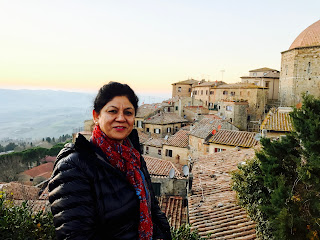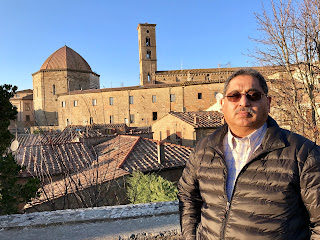Embracing the past (along with all that Tuscan sunshine), Volterra offers the best sightseeing of all of Italy’s small hill towns. Follow me with your traveler’s imagination on a walk through this stony wonder, and you’ll marvel — like me — at why there are almost no tourists here.
Its Etruscan Museum is filled top to bottom with rare artifacts of the mysterious people whose mix of Greek-style art with Roman-style customs created a foundation for the rise of the Roman Empire. And Porta all’Arco, the Etruscan arch built of massive stones in the fourth century B.C., serves as a stately reminder of Volterra’s time as a key trading center.
Through the arch lies Via Porta all’Arco, a steep, atmospheric lane lined with shops featuring the work of artisans and producers. Volterra has a tradition of craftsmanship, and you’ll find a rich variety of handiwork including alabaster, jewelry, etchings and bronze work.
At the top of Via Porta all’Arco lies Volterra’s main square, Piazza dei Priori. It’s dominated by the Palazzo dei Priori (City Hall), said to be the oldest of any Tuscan city-state, built about 1200. A horizontal “cane” cut into its wall served as the local yardstick for the town market, which was held on the square for 1,000 years. Facing City Hall is the Duomo, a church whose simple 13th century facade conceals a more intricate interior (rebuilt in the late 16th and 19th centuries).
Nearby, the town’s main drag, Via Matteotti, illustrates centuries of retrofitting. At No. 12, you’ll find a line of doorbells on a typical palace wall; it was once the home of a single rich family and is now occupied by many middle-class families. After the social revolution in the 18th century and the rise of the middle class, former palaces were condominium-ized. Even so, the original family still lives here.
A block off the main drag behind stone walls, Palazzo Viti’s interior shows how the wealthy lived — in this case, rich from the 19th century alabaster trade. With 12 rooms on one floor open to the public, Palazzo Viti feels remarkably lived in — because it is. You’ll often find Signora Viti herself selling admission tickets; behind the ropes you’ll see intimate family photos. Your visit ends in the cellar with a short wine tasting.
Past Palazzo Viti are the Pinacoteca and Alabaster Museum, filling a 15th century palace with fine Florentine-esque paintings and alabaster sculptures. Next to the museums, a tunnel-like passage leads you to a place where you can access the city wall. Walk along the 13th century wall for a fine aerial view of the Roman theater (there’s no reason to pay to enter). Around the third century A.D., the town began to use the theater stones to build fancy baths instead. You can see the scant remains of the baths behind the theater, including the little round sauna in the far corner with brick supports that raised the heated floor.





















































No comments:
Post a Comment